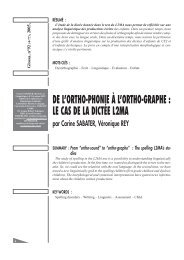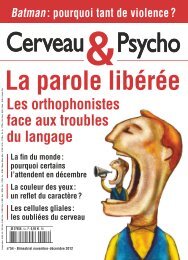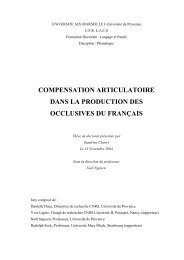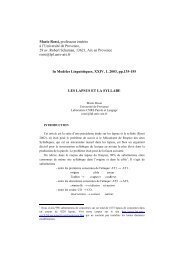measurement and synthesis of the vocal tract of korean ...
measurement and synthesis of the vocal tract of korean ...
measurement and synthesis of the vocal tract of korean ...
You also want an ePaper? Increase the reach of your titles
YUMPU automatically turns print PDFs into web optimized ePapers that Google loves.
MEASUREMENT AND SYNTHESIS OF THE VOCAL TRACT OF KOREAN<br />
MONOPHTHONGS BY MRI<br />
ABSTRACT<br />
The author collected <strong>and</strong> compared midsagittal, coronal,<br />
coronal oblique, <strong>and</strong> transversal images <strong>of</strong> Korean<br />
monophthongs /a, i, e, o, u, ö, Ã/ produced by a healthy male<br />
speaker by MRI. Then, area was measured by computer<br />
s<strong>of</strong>tware after manually tracing <strong>the</strong> cross-section at different<br />
points along <strong>the</strong> <strong>tract</strong>. Results showed that <strong>the</strong> width <strong>of</strong> <strong>the</strong><br />
oral <strong>and</strong> pharyngeal cavities varied compensatorily with each<br />
o<strong>the</strong>r on <strong>the</strong> midsagittal dimension. Formant frequency values<br />
estimated from <strong>the</strong> area functions showed a strong correlation<br />
with those analyzed from <strong>the</strong> spoken vowels. Moreover,<br />
almost all <strong>of</strong> 35 subjects who listened to <strong>the</strong> syn<strong>the</strong>sized<br />
vowels using <strong>the</strong> formant values estimated from area data<br />
perceived <strong>the</strong> syn<strong>the</strong>sized vowels as <strong>the</strong> equivalent spoken<br />
ones. The results may be helpful to verify an exact<br />
<strong>measurement</strong> <strong>of</strong> <strong>the</strong> <strong>vocal</strong> <strong>tract</strong> area through <strong>the</strong> vowel<br />
<strong>syn<strong>the</strong>sis</strong> <strong>and</strong> to make a simulation study before any surgery<br />
on <strong>the</strong> abnormal <strong>vocal</strong> <strong>tract</strong> area.<br />
1. INTRODUCTION<br />
Vowels are produced by varying <strong>vocal</strong> <strong>tract</strong> shapes moving<br />
such articulators as tongue, jaw, <strong>and</strong> lips. Jaw movement leads<br />
to <strong>the</strong> expansion or con<strong>tract</strong>ion <strong>of</strong> oral cavity while <strong>the</strong><br />
tongue controls <strong>the</strong> size <strong>of</strong> <strong>the</strong> front, mid, or back part <strong>of</strong> <strong>the</strong><br />
cavity. The tongue with its constant volume moves forward or<br />
backward to vary <strong>the</strong> oral <strong>and</strong> pharyngeal cavities. Lips play a<br />
role in producing round vowels. Those articulators modify a<br />
speaker's <strong>vocal</strong> <strong>tract</strong> shape to give various auditory<br />
impressions to a listener. Quantitative study on <strong>the</strong> <strong>vocal</strong> <strong>tract</strong><br />
shape may be helpful in <strong>the</strong> underst<strong>and</strong>ing <strong>of</strong> complex vowel<br />
qualities.<br />
Recently many studies on <strong>the</strong> various <strong>vocal</strong> <strong>tract</strong> shapes<br />
using Magnetic Resonance Imaging techniques have been<br />
made because <strong>of</strong> <strong>the</strong>ir advantages: They are not harmful to <strong>the</strong><br />
body <strong>and</strong> multiplane images may be taken [1, 2, 3].<br />
Disadvantages are low resolution images after a fast shot, <strong>and</strong><br />
lack <strong>of</strong> real time representation <strong>of</strong> continuous speech. Baers et<br />
al. compared formant values estimated from <strong>the</strong> MRI <strong>vocal</strong><br />
<strong>tract</strong> area function <strong>of</strong> two speakers <strong>and</strong> those from <strong>the</strong> actual<br />
speech production [1]. There were a few discrepancies between<br />
<strong>the</strong> formant values but <strong>the</strong>y found that <strong>the</strong> syn<strong>the</strong>sized vowels<br />
sounded similar in <strong>the</strong>ir perceptual study. Demolin et al.<br />
measured MRI images <strong>of</strong> French oral vowels produced by two<br />
male <strong>and</strong> two female speakers [4]. They did not find any<br />
systematic relation among <strong>the</strong> four speakers because <strong>of</strong> <strong>the</strong><br />
different <strong>vocal</strong> <strong>tract</strong> lengths but observed some constriction<br />
points at <strong>the</strong> velo-pharyngeal region for back vowels. The<br />
groove size <strong>of</strong> <strong>the</strong> tongue was found to be important for front<br />
vowels but not back vowels. They reported difficulty finding<br />
<strong>the</strong> border <strong>of</strong> air <strong>and</strong> tissue. Yang <strong>and</strong> Kasuya studied three<br />
males <strong>and</strong> three female Japanese speakers' production <strong>of</strong> five<br />
vowels [3]. They compared normalized <strong>vocal</strong> <strong>tract</strong> length<br />
dividing <strong>the</strong> oral, pharyngeal, <strong>and</strong> glottal region. Their results<br />
Byunggon Yang<br />
Dongeui University<br />
showed that <strong>vocal</strong> <strong>tract</strong> dimensions for male <strong>and</strong> female<br />
speakers are continuously distributed <strong>and</strong> <strong>the</strong> <strong>vocal</strong> <strong>tract</strong><br />
length <strong>and</strong> <strong>the</strong> ratio <strong>of</strong> <strong>the</strong> oral cavity to <strong>the</strong> pharyngeal cavity<br />
lead to <strong>the</strong> individual differences. They compensated for <strong>the</strong><br />
area formed by <strong>the</strong> teeth after modelling <strong>the</strong> speakers' teeth.<br />
They pointed out that formant values did not significantly<br />
vary with or without tooth information. Gracco et al. analyzed<br />
three dimensional views <strong>of</strong> normal <strong>and</strong> abnormal people [5].<br />
They could predict fairly well <strong>the</strong> formant values <strong>of</strong> patients<br />
with or without tongue root, epiglottis, <strong>and</strong> false <strong>vocal</strong> folds.<br />
This suggests a possibility <strong>of</strong> simulating speech output before<br />
any physical removal <strong>of</strong> <strong>the</strong> <strong>vocal</strong> <strong>tract</strong> section.<br />
The purpose <strong>of</strong> this study is (1) to ga<strong>the</strong>r midsagittal<br />
images <strong>of</strong> vowels;(2) to obtain cross-sectional area <strong>of</strong> <strong>the</strong><br />
<strong>vocal</strong> <strong>tract</strong> from <strong>the</strong> glottis to <strong>the</strong> lips;(3) to find correlational<br />
coefficient between <strong>the</strong> formant values estimated from <strong>the</strong> area<br />
function <strong>and</strong> those from <strong>the</strong> actual pronunciations;(4) to test<br />
auditory impressions <strong>of</strong> <strong>the</strong> syn<strong>the</strong>sized vowels from <strong>the</strong><br />
formant values estimated from <strong>the</strong> area;(5) to investigate how<br />
each vowel varies from <strong>the</strong> average values <strong>of</strong> <strong>the</strong> corner<br />
vowels /a, i, u/.<br />
2. METHODS<br />
The author collected <strong>and</strong> compared midsagittal, coronal,<br />
coronal oblique, <strong>and</strong> transversal images <strong>of</strong> Korean<br />
monophthongs /a, i, e, o, u, ö, Ã/ produced by a normal male<br />
speaker using 1.5T MR, Vision. The area was obtained while<br />
<strong>the</strong> speaker was producing <strong>the</strong> Korean vowels for 19 seconds<br />
in <strong>the</strong> supine position. Pulse sequences for image acquisition<br />
are Flash 2D, TR 100 ms, TE 5 ms, Flip angle 30, Matrix<br />
98x128, FOV 130 mm, NEX 2, Slice thickness 10 mm. Before<br />
obtaining <strong>the</strong> cross-sectional area, a midsagittal image was<br />
taken to locate proper points <strong>of</strong> imaging around which area<br />
varied greatly along <strong>the</strong> <strong>vocal</strong> <strong>tract</strong>. Four coronal cuts cover<br />
<strong>the</strong> oral cavity including a lip cut. Two or three coronal<br />
oblique cuts cover <strong>the</strong> oro-pharynx <strong>and</strong> velum regions. Three<br />
transversal cuts cover <strong>the</strong> pharynx <strong>and</strong> larynx. The 3rd to 5th<br />
cervical vertebrae were traced to correctly overlap midsagittal<br />
images for comparison. The top-most trace <strong>of</strong> <strong>the</strong> 5th cervical<br />
vertebra was connected to <strong>the</strong> front most part <strong>of</strong> <strong>the</strong> glottis <strong>and</strong><br />
designated as <strong>the</strong> <strong>vocal</strong> fold. Then, area was measured after<br />
manually tracing <strong>the</strong> cross-section at different points along<br />
<strong>the</strong> <strong>tract</strong>. Cross-sectional area was drawn by a pencil on a<br />
transparent paper on a window. The author consulted a doctor<br />
in a hospital when any suspicious border occurred. Then,<br />
midsagittal images <strong>and</strong> cross-sectional areas were scanned into<br />
a computer to measure area by computer s<strong>of</strong>tware, Area<br />
Properties(v. 3.2). The s<strong>of</strong>tware counted <strong>the</strong> screen pixels <strong>of</strong><br />
<strong>the</strong> image <strong>and</strong> scaled <strong>the</strong>m to <strong>the</strong> actual area. A rectangular area<br />
was tested to confirm that <strong>the</strong> program measures <strong>the</strong> area<br />
correctly. The formant values arising from <strong>the</strong> <strong>vocal</strong> <strong>tract</strong> area<br />
were determined by Formfrek [6]. The program calculates<br />
formant values by finding zeroes from <strong>the</strong> system radiation<br />
page 2005 ICPhS99 San Francisco
phase <strong>and</strong> angle. It corrects radiation effects from <strong>the</strong> lips.<br />
Five formant values from <strong>the</strong> lowest were collected.<br />
The formant values from <strong>the</strong> actual speech were obtained<br />
by SFS(Speech Filing System) at 1/3 point <strong>of</strong> <strong>the</strong> total vowel<br />
duration because that point shows sustained formant patterns<br />
[7]. The speaker produced <strong>the</strong> vowel in <strong>the</strong> supine position<br />
after <strong>the</strong> MRI session. Speech syn<strong>the</strong>ses were made by<br />
formant <strong>syn<strong>the</strong>sis</strong> s<strong>of</strong>tware, SenSyn1.0(Sensimetrics).<br />
Amplitude, duration, pitch variation for <strong>the</strong> vowel <strong>syn<strong>the</strong>sis</strong><br />
were measured for each vowel <strong>and</strong> formant values estimated<br />
from <strong>the</strong> MRI area function were input to <strong>the</strong> <strong>syn<strong>the</strong>sis</strong><br />
s<strong>of</strong>tware. Perceptual tests were done in a quiet classroom at a<br />
comfortable level. Listeners circled one <strong>of</strong> <strong>the</strong> seven vowels<br />
on <strong>the</strong> answer sheet while listening to each stimulus.<br />
3. ANALYSIS AND DISCUSSION<br />
3.1 Comparison <strong>of</strong> midsagittal images. The <strong>vocal</strong><br />
<strong>tract</strong> length <strong>of</strong> <strong>the</strong> speaker was measured from <strong>the</strong> midsagittal<br />
images. A Hypertalk program was made to automatically add<br />
up <strong>the</strong> total length <strong>of</strong> <strong>the</strong> <strong>vocal</strong> <strong>tract</strong> by tracing its central<br />
line. The total length was measured to <strong>the</strong> edge <strong>of</strong> lips in <strong>the</strong><br />
midsagittal images. However, <strong>the</strong> cross-sectional area was<br />
measured just a little behind <strong>the</strong> lip ends because it was hard to<br />
measure <strong>the</strong> area at <strong>the</strong> lip ends, <strong>the</strong> section <strong>of</strong> which showed<br />
only partial area. In <strong>the</strong> procedure, <strong>the</strong> central line <strong>of</strong> <strong>the</strong> <strong>tract</strong><br />
around epiglottis, velum, between <strong>the</strong> lower teeth <strong>and</strong> tip <strong>of</strong><br />
<strong>the</strong> tongue abruptly changed its direction but a natural curve<br />
was used to trace <strong>the</strong> length.<br />
The rounded vowel /u/ was 18 cm long. That <strong>of</strong> <strong>the</strong> vowels<br />
/e/ <strong>and</strong> /ö/ is 16.2 cm long. An average value for <strong>the</strong> seven<br />
vowels was 16.9 cm. Thus <strong>the</strong>re is not much length difference<br />
except <strong>the</strong> rounded vowel /u/. Then, midsagittal images <strong>of</strong> <strong>the</strong><br />
seven vowels were compared. Figure 1 shows <strong>the</strong> images <strong>of</strong><br />
<strong>the</strong> three corner vowels /a, u, i/. The third <strong>and</strong> fifth cervical<br />
vertebrae were employed to overlap <strong>the</strong>m. The subject's head<br />
was fixed but still a little vertical movement was possible.<br />
From Figure 2, one can notice that for <strong>the</strong> vowel /i/, <strong>the</strong> tip <strong>of</strong><br />
tongue approaches to <strong>the</strong> hard palate closely. The pharyngeal<br />
section forms a wider area. On <strong>the</strong> o<strong>the</strong>r h<strong>and</strong>, <strong>the</strong> tongue <strong>and</strong><br />
jaw for <strong>the</strong> vowel /a/ move down greatly to form a wider oral<br />
cavity <strong>and</strong> narrower pharyngeal cavity.<br />
The distance between <strong>the</strong> tongue <strong>and</strong> pharyngeal wall <strong>of</strong><br />
<strong>the</strong> vowels /a, i/ shows a difference <strong>of</strong> 0.8 cm. Lips for <strong>the</strong><br />
back vowel /u/ were protruded 1 cm more than those <strong>of</strong> <strong>the</strong><br />
vowel /i/. The subject produced <strong>the</strong> vowel /a/ by both raising<br />
<strong>the</strong> palatal area <strong>and</strong> lowering <strong>the</strong> jaw. Conventionally <strong>the</strong><br />
palatal region was always fixed <strong>and</strong> only jaw movements were<br />
observed to discuss a midsagittal image <strong>of</strong> each vowel<br />
production. Also, <strong>the</strong> subject made most <strong>of</strong> <strong>the</strong> frontal part <strong>of</strong><br />
<strong>the</strong> <strong>vocal</strong> <strong>tract</strong> to secure proper cross-sectional area for <strong>the</strong><br />
front <strong>and</strong> back vowels. The vowel /ö/ has a similar <strong>vocal</strong> <strong>tract</strong><br />
shape like <strong>the</strong> vowel /i/ but <strong>the</strong> frontal section <strong>of</strong> <strong>the</strong> tongue is<br />
wider by 1.5 cm thus <strong>the</strong> tongue volume moves backward with<br />
a narrower pharyngeal cavity. The vowel /ö/ with <strong>the</strong> tip <strong>of</strong> <strong>the</strong><br />
tongue spread to <strong>the</strong> lower teeth is different from <strong>the</strong> vowel /u/<br />
with <strong>the</strong> tip <strong>of</strong> <strong>the</strong> tongue drawn backward to form a pocket<br />
between <strong>the</strong> lower teeth <strong>and</strong> <strong>the</strong> tip <strong>of</strong> <strong>the</strong> tongue. Difference<br />
between <strong>the</strong> rounded vowels /u/ <strong>and</strong> /o/ exists in <strong>the</strong> protruded<br />
lips <strong>and</strong> <strong>the</strong> size <strong>of</strong> <strong>the</strong> pocket formed. The vowels /Ã/ <strong>and</strong> /a/<br />
have similar pharyngeal width but <strong>the</strong> jaw opens more for <strong>the</strong><br />
Figure 1 The images <strong>of</strong> <strong>the</strong> three corner vowels /a, u, i/<br />
collapsed. The thickest line denotes <strong>the</strong> vowel /i/; <strong>the</strong> thinest<br />
line indicates <strong>the</strong> vowel /a/;<strong>the</strong> medium line describes <strong>the</strong><br />
vowel /u/.<br />
vowel /a/. The vowels /o/ <strong>and</strong> /e/ have similar pharyngeal<br />
width but <strong>the</strong> lower lip goes down more for <strong>the</strong> vowel /e/.<br />
So far we have compared <strong>the</strong> width <strong>of</strong> labial, oral,<br />
pharyngeal cavities from <strong>the</strong> midsagittal images. For <strong>the</strong><br />
production <strong>of</strong> vowels, tongue movements seem very<br />
important. Especially, since <strong>the</strong> tongue has a constant<br />
volume, <strong>the</strong> tongue movement leads to a negative correlation<br />
between <strong>the</strong> width <strong>of</strong> oral <strong>and</strong> pharyngeal cavities. Because <strong>the</strong><br />
jaw moves diagonally to <strong>the</strong> glottal area, <strong>the</strong> amount <strong>of</strong> area<br />
change increases with <strong>the</strong> distances from <strong>the</strong> glottis. The<br />
greatest width <strong>of</strong> lips was observed for <strong>the</strong> vowel /a/ followed<br />
by /e, Ã, i, ö, o, u/. There is not much variation in <strong>the</strong> width <strong>of</strong><br />
oral <strong>and</strong> pharyngeal cavities from <strong>the</strong> midsagittal images.<br />
Also, <strong>the</strong> length variation seems small enough to be<br />
perceptually negligible. When one considers that 1 cm<br />
difference in <strong>the</strong> <strong>vocal</strong> <strong>tract</strong> length led to about 200 Hz for F 3<br />
[7] which causes little perceptual difference [8], <strong>the</strong> length<br />
seems to contribute little to <strong>the</strong> vowel variation.<br />
3.2 Comparision <strong>of</strong> <strong>vocal</strong> <strong>tract</strong> area. Table 1 lists <strong>the</strong><br />
distance from <strong>the</strong> glottis <strong>and</strong> its area at each crossing point in<br />
<strong>the</strong> <strong>vocal</strong> <strong>tract</strong>. If one looks at <strong>the</strong> area difference, <strong>the</strong> vowels<br />
/i/ <strong>and</strong> /e/ at 7.5 cm from <strong>the</strong> glottis differ from each o<strong>the</strong>r<br />
around 6 cm 2 ; around 3.3 cm 2 , at 14 cm. The pharyngeal area<br />
difference is almost twice that <strong>of</strong> <strong>the</strong> oral cavity. For vowel /i/<br />
<strong>and</strong> /ö/, <strong>the</strong> difference at 7 cm amounts to 8 cm 2 . Compared to<br />
<strong>the</strong> width difference <strong>of</strong> 1.5 cm in <strong>the</strong> midsagittal images, <strong>the</strong><br />
area results in greater difference. Thus, midsagittal<br />
comparison alone may not be sufficient to reflect <strong>the</strong><br />
anatomical difference. The back vowels /Ã, o, u/ form<br />
constriction points around 8~9 cm from <strong>the</strong> glottis. The<br />
vowel /a/ has a lower<br />
page 2006 ICPhS99 San Francisco
e ö Ã a i o u<br />
dist area dist area dist area dist area dist area dist area dist area<br />
0.00 2.88 0.00 2.16 0.00 2.78 0.00 2.10 0.00 2.60 0.00 2.53 0.00 2.99<br />
0.87 1.59 0.96 2.48 2.34 6.59 1.75 1.68 3.01 2.71 1.86 3.91 1.65 8.03<br />
3.19 5.85 2.96 5.29 4.87 2.67 4.12 2.75 4.56 7.19 3.87 3.69 3.82 8.51<br />
4.80 6.09 4.71 5.87 7.25 2.95 6.66 1.87 7.27 10.04 5.60 1.80 5.45 5.22<br />
7.33 3.89 7.62 1.40 8.48 2.24 8.23 2.19 8.77 4.70 7.72 1.51 7.42 1.71<br />
8.86 4.04 9.18 1.45 10.90 6.01 10.90 7.67 10.80 2.56 9.37 1.35 9.24 1.49<br />
10.60 2.80 11.10 2.39 12.20 8.28 12.40 10.98 12.30 0.84 11.52 6.91 11.70 3.96<br />
12.10 2.52 12.60 2.97 13.80 6.82 14.20 12.29 13.90 0.71 13.28 10.04 13.60 13.04<br />
13.80 4.05 13.90 4.44 16.50 7.66 16.70 8.99 15.10 0.75 15.01 7.06 15.20 6.10<br />
16.20 8.30 16.20 3.27 17.10 4.30 17.38 2.94 18.00 0.74<br />
Table 1. Vocal <strong>tract</strong> areas <strong>of</strong> <strong>the</strong> seven Korean vowels at <strong>the</strong> distance(dist) from <strong>the</strong> glottis.<br />
constriction point (6.7 cm) because <strong>the</strong> subject lowered <strong>the</strong><br />
jaw. The front vowel /i/ has a constriction point at 14 cm. For<br />
<strong>the</strong> vowel /e/ it is at 12 cm in <strong>the</strong> middle <strong>of</strong> <strong>the</strong> oral cavity.<br />
The vowel /ö/ has a constriction point at 8 cm, thus it might<br />
be closer to <strong>the</strong> back vowel /u/. The vowel /Ã/ has similar area<br />
difference for <strong>the</strong> vowel /a/ at both oral <strong>and</strong> pharyngeal cavity.<br />
Area difference for <strong>the</strong> vowel /ö/ <strong>and</strong> /u/ is about 1 cm 2 .<br />
Lowering <strong>the</strong> back portion <strong>of</strong> <strong>the</strong> tongue widens both <strong>the</strong> oral<br />
<strong>and</strong> pharyngeal cavity by 3 cm 2 .<br />
How does <strong>the</strong> volume <strong>of</strong> <strong>the</strong> <strong>vocal</strong> <strong>tract</strong> vary with each<br />
vowel? To check <strong>the</strong> volume, data for each area were summed<br />
up by using <strong>the</strong> Area Properties. The volume varies from <strong>the</strong><br />
vowel /o/ (78.8 cm 3 ) to <strong>the</strong> vowel /ö/ (103.4 cm 3 ). The general<br />
trend shows that <strong>the</strong> high vowels have smaller volume than<br />
<strong>the</strong> low vowels. This might come from <strong>the</strong> combination <strong>of</strong><br />
tongue <strong>and</strong> jaw movements.<br />
We obtained 17 cm 3 at <strong>the</strong> pharyngeal section at 8 cm<br />
from <strong>the</strong> glottis while 74 cm 3 at <strong>the</strong> oral section for <strong>the</strong> vowel<br />
/a/. For <strong>the</strong> vowel /ö/, <strong>the</strong> pharyngeal section amounts to 58<br />
cm 3 , <strong>and</strong> <strong>the</strong> oral section, 28 cm 3 . There is around 5 cm 3<br />
difference in volume. Thus, <strong>the</strong> tongue <strong>and</strong> jaw movements<br />
seem to change <strong>the</strong> ratio <strong>of</strong> oral <strong>and</strong> pharyngeal cavities but<br />
<strong>the</strong> total volume does not vary much. For <strong>the</strong> vowel /u/, <strong>the</strong><br />
two cavities are divided into about <strong>the</strong> same volume (43 cm 3 )<br />
at 9 cm from <strong>the</strong> glottis. Thus, tongue movement seems to<br />
play a greater role in <strong>the</strong> volume control <strong>of</strong> <strong>the</strong> <strong>vocal</strong> <strong>tract</strong>.<br />
3.3 Formant value estimation by area function<br />
<strong>and</strong> <strong>syn<strong>the</strong>sis</strong>. Table 2 lists formant values analyzed from<br />
actual speech by SFS as well as those from <strong>the</strong> area functions.<br />
The values were input to <strong>the</strong> formant syn<strong>the</strong>sizer. The<br />
syn<strong>the</strong>sized vowels were presented to fifty students with<br />
normal hearing ability in a quiet classroom at a comfortable<br />
level. On an answer sheet, three sets <strong>of</strong> seven vowels were<br />
r<strong>and</strong>omly presented. They listened to <strong>the</strong> stimuli <strong>and</strong> circled<br />
<strong>the</strong> vowel <strong>the</strong>y hear. To avoid <strong>the</strong> initial confusion, only <strong>the</strong><br />
answers from <strong>the</strong> 9th row were counted. Also fifteen students<br />
who could not tell <strong>the</strong> vowel /Ã/ from <strong>the</strong> vowel /ö/ were<br />
rejected because <strong>the</strong>ir decision would be done by chance for <strong>the</strong><br />
vowels. Five cases were reported in which <strong>the</strong> vowel /o/ was<br />
heard as <strong>the</strong> vowel /Ã/. One case showed a confusion on <strong>the</strong><br />
vowels /ö/ <strong>and</strong> /o/. Almost all <strong>of</strong> <strong>the</strong> syn<strong>the</strong>sized vowels were<br />
heard as <strong>the</strong> corresponding vowels.<br />
Formant from Speech Formant from Area<br />
Vowel F1 F2 F3 F1 F2 F3<br />
a 744 1167 2816 762 1243 2691<br />
e 544 2027 2672 492 1726 2487<br />
à 526 1120 2818 545 1229 2482<br />
o 412 738 2620 473 928 2727<br />
ö 311 1387 2445 430 1387 2803<br />
u 296 706 2344 244 729 2802<br />
i 284 2377 3093 264 2141 2679<br />
Table 2. Formant values obtained from actual speech <strong>and</strong><br />
estimated from area function.<br />
This result was supported by a strong correlation<br />
coefficient (0.978) between <strong>the</strong> formant values estimated from<br />
<strong>the</strong> area function <strong>and</strong> actual speech. Here F 3 values show some<br />
difference but considering that 800 Hz variation in F 3 did not<br />
affect <strong>the</strong> auditory impression <strong>of</strong> vowels, <strong>the</strong> results seem to<br />
be expected.<br />
If <strong>the</strong> constriction points <strong>of</strong> <strong>the</strong> <strong>vocal</strong> <strong>tract</strong> moved, what<br />
would be <strong>the</strong> resulting formant frequency <strong>and</strong> auditory<br />
impression <strong>of</strong> <strong>the</strong> syn<strong>the</strong>sized vowel? This study may be<br />
helpful to simulate patients with cancerous cells or edema on<br />
<strong>the</strong> <strong>vocal</strong> <strong>tract</strong> before <strong>the</strong>ir removal [7]. In fact, <strong>vocal</strong> <strong>tract</strong><br />
area can vary greatly but <strong>the</strong>re is a physical limitation to <strong>the</strong><br />
movement <strong>of</strong> articulators. Especially, <strong>the</strong>re are some regions<br />
in which small articulatory variation leads to large acoustic<br />
change in formant values <strong>and</strong> vice versa [9, 10]. For example,<br />
<strong>the</strong>re was not much variation in syn<strong>the</strong>sized vowel qualities<br />
even though <strong>the</strong> constriction point moved around <strong>the</strong> velum<br />
region. Thus one may need a st<strong>and</strong>ard point to start with<br />
page 2007 ICPhS99 San Francisco
ecause o<strong>the</strong>rwise <strong>the</strong> combination <strong>of</strong> <strong>the</strong> size <strong>of</strong> oral <strong>and</strong><br />
pharyngeal cavities would be unlimited. Figure 2 shows <strong>the</strong><br />
chart <strong>of</strong> <strong>the</strong> corner vowels /a, u, i/ <strong>and</strong> <strong>the</strong>ir average.<br />
Figure 2 The area <strong>of</strong> <strong>the</strong> three corner vowels /a, u, i/ <strong>and</strong> <strong>the</strong>ir<br />
average.<br />
In Figure 2 a constriction point <strong>of</strong> <strong>the</strong> average was made<br />
at 9 cm from <strong>the</strong> glottis. Subjects answered to <strong>the</strong> perceptual<br />
stimulus <strong>of</strong> <strong>the</strong> syn<strong>the</strong>sized vowel estimated from that area<br />
function as /Ã/ (549 out <strong>of</strong> 560 responses). Seventeen subjects<br />
heard it as <strong>the</strong> vowel /ö/ while two as <strong>the</strong> vowel /o/. If one<br />
looks at <strong>the</strong> three vowels from <strong>the</strong> average area values, <strong>the</strong><br />
area variation should be made by compensating <strong>the</strong> one cavity<br />
for <strong>the</strong> o<strong>the</strong>r. In o<strong>the</strong>r words, since <strong>the</strong> total <strong>vocal</strong> <strong>tract</strong> is<br />
somewhat constant, if <strong>the</strong> oral cavity is reduced by <strong>the</strong> tongue<br />
raising, <strong>the</strong>n <strong>the</strong> pharyngeal cavity must be exp<strong>and</strong>ed<br />
accordingly. This way one could account for <strong>the</strong> physical<br />
limitation <strong>and</strong> naturalness in <strong>the</strong> articulatory movement.<br />
4. CONCLUSION<br />
In this study, midsagittal images <strong>and</strong> area values <strong>of</strong> <strong>the</strong> seven<br />
vowels produced by a healthy Korean male were examined.<br />
Then, perceptual experiment on <strong>the</strong> syn<strong>the</strong>sized vowels<br />
estimated from <strong>the</strong> area function was made. Also, <strong>the</strong> average<br />
values <strong>of</strong> <strong>the</strong> three corner vowels were determined to reflect <strong>the</strong><br />
physical limitation to <strong>the</strong> area variation. Results showed that<br />
<strong>the</strong> width <strong>of</strong> <strong>the</strong> oral <strong>and</strong> pharyngeal cavities varied<br />
compensatorily with each o<strong>the</strong>r on <strong>the</strong> midsagittal dimension.<br />
Formant frequency values were estimated from <strong>the</strong> area<br />
functions <strong>of</strong> <strong>the</strong> seven vowels using Formfrek. Statistically,<br />
<strong>the</strong> values showed a strong correlation with those analyzed<br />
from <strong>the</strong> spoken vowels. Moreover, almost all <strong>of</strong> <strong>the</strong> subjects<br />
who listened to <strong>the</strong> syn<strong>the</strong>sized vowels using <strong>the</strong> formant<br />
values estimated from <strong>the</strong> area data perceived <strong>the</strong> syn<strong>the</strong>sized<br />
vowels as <strong>the</strong> equivalent spoken ones. Movements <strong>of</strong><br />
constriction points <strong>of</strong> <strong>the</strong> vowel /u/ with a wider lip opening<br />
sounded /ö/ <strong>and</strong> led to slight changes in vowel quality. The<br />
formant values estimated from <strong>the</strong> average area function <strong>of</strong> <strong>the</strong><br />
three corner vowels /a, i, u/ were employed to syn<strong>the</strong>size a<br />
vowel which was identified as <strong>the</strong> vowel /Ã/ by almost all <strong>of</strong><br />
<strong>the</strong> subjects. The volume <strong>of</strong> each vowel was estimated from <strong>the</strong><br />
integral sum <strong>of</strong> <strong>the</strong> area along <strong>the</strong> <strong>tract</strong>. Jaw <strong>and</strong> tongue<br />
movements led to <strong>the</strong> major volume variation within <strong>the</strong><br />
anatomical limitation. Each corner vowel varied<br />
systematically from a ra<strong>the</strong>r constant volume <strong>of</strong> <strong>the</strong> average<br />
area <strong>of</strong> <strong>the</strong> three corner vowels. Thus, <strong>the</strong> author proposes that<br />
any simulation studies related to <strong>the</strong> <strong>vocal</strong> <strong>tract</strong> area variation<br />
reflect its constant volume. The results may be helpful to<br />
verify an exact <strong>measurement</strong> <strong>of</strong> <strong>the</strong> <strong>vocal</strong> <strong>tract</strong> area through <strong>the</strong><br />
vowel <strong>syn<strong>the</strong>sis</strong> <strong>and</strong> a simulation study before any surgery on<br />
<strong>the</strong> abnormal part in <strong>the</strong> <strong>vocal</strong> <strong>tract</strong>.<br />
REFERENCES<br />
[1] Baers, T., Core J.C., Gracco L.C., <strong>and</strong> Nye P.W. 1991. Analysis <strong>of</strong><br />
<strong>vocal</strong> <strong>tract</strong> shape <strong>and</strong> dimensions using magnetic resonance imaging:<br />
vowels. Journal <strong>of</strong> Acoustical Society <strong>of</strong> America, 90, 2, 799-828.<br />
[2] Yang, C.S <strong>and</strong> Kasuya H. 1994. Accurate Measurement <strong>of</strong> <strong>vocal</strong><br />
<strong>tract</strong> shapes from magnetic resonance images <strong>of</strong> child, female<br />
<strong>and</strong> male subjects. Procedings International Congress <strong>of</strong> Speech <strong>and</strong><br />
Language Processing 94, 623-626.<br />
[3] Yang, C.S. <strong>and</strong> Kasuya H. 1996. Speaker individualities <strong>of</strong> <strong>vocal</strong><br />
<strong>tract</strong> shapes <strong>of</strong> Japanese vowels measured by magnetic resonance<br />
images. Procedings International Congress <strong>of</strong> Speech <strong>and</strong> Language<br />
Processing 96, 949-952<br />
[4] Demolin, D., Metens T., <strong>and</strong> Soquet A. 1994. Three-dimensional<br />
<strong>measurement</strong> <strong>of</strong> <strong>the</strong> <strong>vocal</strong> <strong>tract</strong> by MRI. Procedings International<br />
Congress <strong>of</strong> Speech <strong>and</strong> Language Processing 96, 272-275.<br />
[5] Gracco, C., Sasaki C.T., McGowan R., Tierney E., <strong>and</strong> Gore J.<br />
1994. Magnetic resonance imaging(MRI) in <strong>vocal</strong> <strong>tract</strong> research:<br />
clinical application. 127th Meeting <strong>of</strong> Acoustical Society <strong>of</strong> America<br />
Abs<strong>tract</strong> lpSP35.<br />
[6] Liljencrants, J. <strong>and</strong> Fant G. (1975) Computer program for VTresonance<br />
frequency calculation. STL-QPSR, 4, 15-21.<br />
[7] Yang, B. 1996. A comparative study <strong>of</strong> American English <strong>and</strong><br />
Korean vowels produced by male <strong>and</strong> female speakers. Journal <strong>of</strong><br />
Phonetics, 24, 1, 245-261.<br />
[8] Yang, B. 1998. Vowel perception by formant variation. Proceedings<br />
Acoustical Society <strong>of</strong> America 98, 3005-3006.<br />
[9] Stevens, K.N. 1972. The quantal nature <strong>of</strong> speech: evidence from<br />
articulatory-acoustic data. In David, E.E. & Denes, P.B., eds. Human<br />
Communication: a Unified View, 51-66.<br />
[10] Wood, S. 1979. A radiographic analysis <strong>of</strong> constriction locations<br />
for vowels. Journal <strong>of</strong> Phonetics, 7, 25-43.<br />
page 2008 ICPhS99 San Francisco








